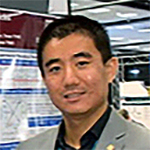Electrochemical energy storage devices (EESDs) are in demand for portable electronic devices, smart grid, hybrid or electric vehicles, and energy recovery systems. To date, lithium ion batteries (LIBs) and supercapacitors (SCs) are two typical mediums of storage. This research aims at design, fabrication, and characterization of electrodes made of novel hierarchical nanocomposites. Firstly, various types of metallic current collectors with highly porous morphology are fabricated and characterized. Nanostructured, shape-specific, and electrochemically active transition metallic oxide (TMO) particles are subsequently synthesized and directly deposited on such porous current collector. This combination of nanostructured TMO particles and porous current collectors establishes the hierarchical micro-architecture of advanced electrodes. Meanwhile, facile and novel binder-free processing is applied during the assembly. Electrochemical characterization and analysis are conducted to understand the mechanisms of electrochemical interactions, ion transport, and energy storage. The ultimate purpose of this research is to design better electrodes with greater energy density, longer lifespan, enhanced cyclic stability, and lower cost.





